The Parks of Salento, Italy: a path for sustainable tourism
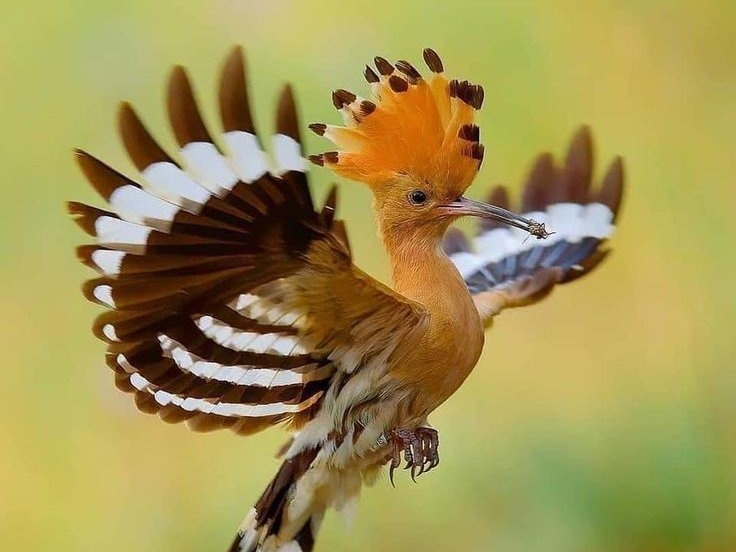
Piscopo-Clinto, 2015
1. Coastal Dunes Nature Park from Torre Canne to Torre San Leonardo
Imagine cycling through a variety of habitats, from beaches protected by sand dunes covered with 600-year-old juniper bushes to marshes and then on to fossil sand dunes and pseudo-steppe, arid in summer but brightly colored in spring with the blooming of wild orchids, especially the Apulian Serapis, a rare native species. And then imagine continuing the tour to the plains called zoppe and the countryside with its centuries-old olive trees, pastures and crops.
Slow steps on the sand, where the beach meets the sea. Here the Posidonia represents a refuge for a large number of marine species and plays a fundamental role in protecting the coasts from erosion caused by the crashing waves. Although the leaves that accumulate at the water's edge in winter may be unsightly, they serve a vital purpose, forming a natural barrier against beach washout, while ensuring the balance of beaches and dunes.
Unfortunately, human interference can destroy this delicate balance between the beach and the dunes, for example during beach cleaning. And if the beach disappears, the dune, which is where the sand accumulates, is quickly swept away.
ORGANIC FISH FARMS ALONG THE RIVERS
The next stop takes us to the back-dune marshes with their karst springs, whose waters are brackish due to the proximity of the sea, where eels and golden mullets are free to come and go, migrate and then return. These are basins of ancient fishing valleys dating back to the 13th century.
THE SURVIVING JUNIPER
Although they have now become a rarity, at risk of extinction, the centuries-old junipers, in the two species Oxycedrus and Phoenician, grow around the Morelli River, together with the mastic tree, the myrtle, the Sicilian tea and a very varied fauna that goes from the green toad to the edible frog, from the European marsh turtle to the kingfisher, expert in catching fish in the marshes.
THE BIRDS OF THE PARK
Are you ready to discover the wild birds that live in the Park? As many as 114 species have been sighted, including many protected species. It is best to come in spring, between March and April, to see the many birds of prey in transit along the Adriatic coast. For birdwatching, arm yourself with binoculars, a telescope, a guide and a camera. Keep looking and you will see marsh harriers, Montagu's harriers, hen harriers and the rarer pallid harriers, flying over the fields in search of water voles and small birds. Red-legged hawks, on the other hand, adopt a special hunting technique, called "Holy Spirit": they remain suspended against the wind, watching over the pastures and crops from above, hunting for prey. Various species of aquatic birds hide in the coastal wetlands: from the teal to the garganey, from the northern shoveler to the little bittern and the purple heron. The little egret is recognizable by its white plumage, with a black beak and legs. The grey heron can be seen perched in trees or resting on the water.
The park is home to ancient caves, with traces of prehistoric life. Among these, particularly interesting are Lamacornola, which preserves the remains of medieval villages, and Lama Torrebianca, one of the wildest and most evocative of the Park; a place so fascinating that it has been chosen as a set for numerous films and shorts.
AN UNDERGROUND WORLD
ON FOOT OR ON HORSEBACK
If you love walking, visit the Park on foot, following the marked trails. Don't forget to put a pair of sandals in your backpack, because the Lido Morelli walk, which lasts an hour and a half, leads to the coastal area with its wetlands, marshes, valleys and sand dunes carpeted with thyme and wild orchids. The other trail will take you in two hours to discover the rock villages along the karst river of Lamacornola. An alternative to trekking? Take an unforgettable horseback ride to the coast, among the Mediterranean scrub and the timeless olive trees, this will help promote sustainable tourism.
2.Torre Guaceto Nature Reserve
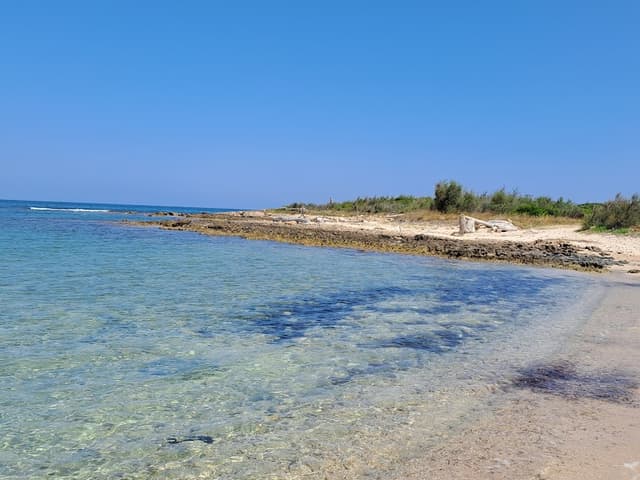
Torre Guaceto is a wonderful surprise. Its underwater environment is one of the richest and most varied, as snorkeling enthusiasts will discover. A few meters deep, the grassy mantle formed by algae such as the large cistoseria, the Y-branched algae and the Flabellia petiolata, hides a myriad of organisms. Breams and saddled seabreams, damsels and peacocks dart among the rocks, while literally attached to the seabed are many Anthozoans, such as sea anemones and the Cladocora caespitosa, which looks like a cushion of flowers and is the largest of the Mediterranean madrepores, present in large quantities right in front of the Tower. Going even deeper, you come across the meadows of Posidonia oceanica rich in Pinna Nobilis, large sea urchins, squid, octopuses and sea anemones and then the coralligenous, a spectacle that is the favourite destination of the divers who visit the Reserve every year: a true explosion of colours with its yellow and white gorgonians, sea daisies, false coral and sponges, such as the large fan sponge, where the squid lay their eggs.
OBSERVING THE MAQUIS
FAUNA
Where the water is less salty, reptiles and amphibians live, such as the ringed snake and the sea turtle, but this habitat is mainly the kingdom of birds; some of them spend their entire lives here, such as the bittern, which hides by remaining still for a long time, or by waving like the reeds in the wind. If disturbed, it assumes a funny position, stretching its neck and beak upwards, to camouflage itself among the reeds. Others, such as starlings and swallows, use the reeds of Torre Guaceto for a short stop, even for just one night, during their migratory journeys.
NATURAL SCULPTURES
A sea of centuries-old trees with silver-green leaves that shine in the sun: this is what the monumental olive grove looks like, one of the oldest in Puglia: dotted with dry stone walls and farmhouses, it extends between Castello di Serranova and Punta Penna Grossa. Arm yourself with a camera, it will be worth it. The trees, some enormous, with their gnarled and twisted trunks are true natural monuments.
RECOMMENDED ACTIVITIES:
BIKE
Cycle through the Torre Guaceto park and discover its incredible variety of habitats. Starting from the cycle path in the marine area, after 3 kilometers you will reach the coastal tower, which dominates the rest of the reserve from a promontory suspended over the sea.
WALK IN THE RESERVE
Always bring a swimsuit and a towel, a swimming cap and drinking water for this two and a half hour guided walking tour through the reserve. Recommended for the summer months, from May to September, it is suitable for both children and adults. Leave your car at the Punta Penna Grossa car park and walk for about 3 kilometres, along paths in the Mediterranean masquis scented with mastic, thyme and rosemary, which lead to small sandy coves where you can stop for a swim. From here you continue to the tower, which offers a beautiful view, and then continue in silence along the paths in the reeds, watching the birds.
SEAWATCHING
If the sea is calm you can have a unique experience, asking to be accompanied by the park staff on a dive around the tower, with fins and mask, to observe the seabed of the marine protected area, uncontaminated for over 20 years.f the sea is calm you can have a unique experience, asking to be accompanied by the park staff on a dive around the tower, with fins and mask, to observe the seabed of the marine protected area, uncontaminated for over 20 years.
GUIDED DIVES
If you already have a scuba diving license, you can explore the deepest depths with an expert guide and discover the biodiversity and the most spectacular environments of the marine protected area.
BOAT TRIP
There is another way to discover the coastal landscape of Torre Guaceto: book an excursion with the fishermen of the reserve, listen to their stories, their old tales, their memories and their wisdom.
THEATRE UNDER THE STARS
In summer, especially in August, don't miss the concerts, the storytelling, the food and wine tastings, the theatrical performances, or anything else in the rich calendar of events set in the fascinating scenery of the reserve at night, suspended between sea and land, illuminated only by the moon.
3. Parco Naturale di Rauccio

FROM RAGUCCIO TO THE PARK
Why Rauccio? It is named for Raguccio Maresgallo, former owner of the farmhouse built in the 17th century or before as defence against pirates and brigands. In 1700, the farm was bought by the Dominicans of Lecce. It was a grazing farm with pastures for sheep and cattle, Mediterranean maquis, olive trees and an ilex grove. Remaining today is the tower, an imposing stairway with a drawbridge and the ruins of an ancient dove tower. Bought by the City of Lecce, it now houses the WWF of Salento and the Sea Turtle Protection Centre, where many Caretta caretta, injured in accidents at sea, have been treated and released.
THE WOODS AND MARSHES
The ilex woods is the last outpost of the Lecce Forest, which in the late 13th century stretched as far as the eye could see between the city and the sea and from Otranto to Brindisi. Remaining of the forest, cleared to make room for fields and olive groves, is the Rauccio Woods, which escaped thanks to the rocky soil that made it unsuitable for farming, and was long used as a hunting reserve. The majestic ilexes open the "doors" of the forest. Soaring over 20 metres high, with intercrossing branches, they create a play of light. Only if accompanied by the park guides can you venture into the underbrush to observe the Mediterranean maquis. In spring, the scent of blossoming shrubs - wild madder, lentiscus, winter savory and myrtle - is inebriating, but don't pick them! The ditch reeds dominate the marshland, where the silk vine clings to the shrubs.
THE SANDY BEACH
In the past the sand dunes were monumental, up to ten metres high. Today, due to constructions and bathing establishments, they are little hills covered with plants such as the sea daffodil, the spiny sea-fennel and the Cretan trefoil. Dividing the dunes and the beach from the interior are the banks of the Idume basin, where a colony of crested coots hides among the reeds. Coming here to find food are herons, little egrets, common sandpipers and, at times, swans. Narrow paths follow the canals, and from the wooden footbridges you can admire the crystal-clear, transparent water.
THE BOTANY TRAIL
Walk slowly through the ilex woods with the Park guides, who will let you discover the colours of nature and will tell you the myths and legends linked to each plant. Observe the mistletoe with its red berries, the daphne with its white flowers and the sarsaparilla, a thorny liana with heart-shaped leaves, also called "straccia- braghe", which together with the ivy and the wild madder (Rubia peregrina), in dialect, "Ziccate a mie", climbs up the tree trunks in search of the sun. In autumn, mushrooms and Neapolitan cyclamens emerge, and in spring the purple flowers of the silk vine and the very rare saltmarsh morning glory with its pinkish hues, the yellow of the Ionian helianthus and the deep blue of wild flax appear. And everywhere is the winter savory, spreading its intense fragrance. From the woods go on to the saline steppe and then to the marches of the Specchia di Milogna, and from there to the stretches of glasswort and marsh orchids.
RARE AND PRECIOUS PLANTS
There are thirty or so rare plants in the Park, all with names hard to pronounce. In the top ten are the famous silk vine (Periploca graeca), which, along with the marsh orchid (Orchis palustris), the three-awn goatgrass and the marsh bellflower, is included in the "National Red List" of species at risk of extinction. And on the regional scale? These are the threatened species: the land quillwort, the coast lily and the chickweed.
THE FAUNAL TRAIL
It is hard to see animals in the Park, but their traces are every- where: footprints, dens, feathers, hairs or the remains of a meal. Keep quiet and strain your eyes to sight foxes, stone-martens, weasels, and to watch the flight of migratory birds such as the grey heron, the little egret and the common sandpiper. In spring and summer you may happen upon snakes warming themselves in the sun, bright green lizards, the all-black rat snake and the four-lined snake, which can reach a length of two metres. But don't worry, they are not poisonous and are harmless even if disturbed.
THE WATERWAYS
The trail from the Forest to the coastal Idume basin is about 3 kilometres long, to be covered on foot or by bike. Make a stop at the "aisi", the karst springs, to watch frogs leaping in the water, then go on to explore the marches as far as the Idume basin. The path winds along the drainage canals - Fetida, Gelsi and Rauccio amid springs and forms of aquatic life, until it reaches the sea. An interesting experi- ment you can do with children is measuring the Ph of the water.
PEDALLING ON TWO WHEELS
The historical-cultural trail leads past farmhouses, "pajare" (stone structures used by the farmers as shelter, as stalls for their animals, or as tool sheds) amid stretches of olive trees, up to the Abbey of Santa Maria di Cerrate, a 12th-century masterpiece; and from the Masseria di Rauccio to the Masseria Barone Vecchio, then to La Grotta and through the olive groves of the Masseria Li Ronzi, Monacelli and Giampaolo.
4. Nature Reserve "Le Cesine"

CESINE
"Uncultivated and abandoned", this is the meaning of the name Cesine, perhaps from the Latin Seges. Kilometers of marshes and swamps once stretched along this coast from Brindisi to Otranto. Malaria was endemic here, making cultivation and livestock farming impossible. No coastal tower was ever built in this area. The marshes were sufficient to defend it from Turkish incursions.
FLYING HIGH
Imagine surveying the reserve from above. What an infinite variety of landscapes you can see: from Aleppo pine and holm oak forests to Mediterranean scrub, from the reed beds in the two marshes to the sand dunes that separate them from the sea. In the eastern part there are perennial lakes, woods and steppe; in the western part, pine forests, Mediterranean scrub, agricultural land and the 16th century farmhouse-tower.
ON THE DUNES ALONG THE SHORE
The conditions in this area are extreme: the soil is arid, scorching hot in summer, highly saline, swept by strong winds from the sea. What plant species are able to survive here? The sea spurge, the sand grass and the sand reed, whose roots search for water deep in the soil; the sea narcissus and the sea bindweed, with their shiny, fleshy leaves; the carnation flower and the sea elder, covered in down; the cade, which grows only sparsely here, with its needle-like leaves that serve to retain water. And the animals? Apart from some reptiles, including the Italian lizard, only invertebrates such as beetles manage to survive in these harsh conditions. As for birds, in winter you can spot the dunlin and the black-bellied plover; and in spring the woodcock and the curlew.
WETLANDS
Home to rare plant and animal species, this is an oasis where over 180 species of birds stop to rest during migration. From the observation decks, you can discover them. In winter, ducks and coots find shelter in the peat bogs and white-eyed pochards build their nests. You can see cormorants, kingfishers and grey herons in the waters of the marsh. In spring and autumn, however, large birds of prey arrive, such as marsh harriers and fish eagles, flocks of red-footed falcons and Montague harriers. Rushes and reeds thrive in the less saline marshes, where you can easily see wild orchids and marsh bellflowers, both protected species; while the iris or water flag blooms around the freshwater marshes.
In spring, you can watch thousands of butterflies in flight and sometimes witness the nuptial dance of harmless rat snakes. At night, towards the end of winter, the toads' song joins the croaking of the green toad and the common toad, while in summer the Italian edible frog makes its presence felt. A myriad of wild orchids bloom in spring: the Ophrys, whose flowers resemble insects; the Serapias, night-time roosts for small animals, and the Orchis, whose powerful scent attracts insects.
Charaxes Jasius
DISCOVERING THE PARK
NATURE PATHS
The appointment to visit the Reserve and discover its incredible variety is every Sunday at 10:30 from October to April, and at 16:30 in the summer. Starting from the visitor center, a beautiful 16th century farmhouse with a tower, two nature trails branch off. The "Sentiero del Tasso", 6 km long, is the wildest, which leads to the high observation hut, a wooden house on stilts where you can observe the birds of the Pantano Grande marshes. The "Sentiero Imbarcadero", more educational, is almost 5 km long and is also suitable for disabled and blind people, with panels that tell the story of the Park, illustrating its habitats, flora and fauna. Allow at least two hours to explore a good part of it.
TREKKING OR BICYCLE?
You can decide to explore the Oasis on foot or by bicycle. The "Trekking" route, about fifteen kilometers long, starts from the Masseria Le Cesine and crosses all the habitats of the Reserve, including the reclamation system that transformed the ancient marsh into a protected area. It then runs along the Campolitrano canal and "La Strada del Pesce", an ancient municipal road that once served to reach the sea, crossing the marshes. Leaving the reserve, you can continue to the Cesine beach. Cyclists can rent bicycles at the Masseria and take a guided tour 20 km along the two nature paths, going on to explore the Northern zone and then the Southern one along trails through the interior.
ON HORSEBACK ALONG THE BEACH
The Masseria Fossa, halfway between Lecce and the village of Acaya, houses the Centro Ippico I-qe-ja, which organises trekking on horseback all year long. It is thrilling to ride over the Masseria Fossa - Cesine bridle path (20 km, medium level difficulty), through fields with artificial ponds, long sheep tracks connecting the local farmhouses, dating from the 17th to the 20th century, one of them coinciding with the ancient Roman centuriate. To arrive at the beach, you will ride through olive groves, along the shore, past the drainage canal and through the pinewoods of the Reserve,
KITES FLYING HIGH
The nearby Torre Specchia Ruggeri is a popular meeting place for surfers. Here, thanks to a wind that never stops blowing, windsurfing and kitesurfing are favourite sports. For beginners, lessons are held on the beach, taught by professional instructors. In only three days of lessons, you can "fly" on your board over the water.
5.Otranto Coast, S. Maria di Leuca and Tricase Forest Nature Park
Parading before your eyes are sun-drenched fields protected by dry- stone walls, fragrant with lentiscus, and stone "pajare", for centuries the temporary shelter of shepherds and peasants. Towns steeped in history, such as Otranto, Castro, Santa Maria di Leuca, and a shoreline marked by coastal towers built from the late 13th to the first decades of the 16th century, recording Saracen invasions and terrible fear. In the first section you will see level land and low coast- lines, then further south, rocky coves with cliffs overhanging the coastline, high and jagged with its bays and cav- erns. On the rocks near the sea only special plants can survive, sea fennel and grasswort, resistant to strong winds, burning sun and arid soil. On the rocky walls there blossom in spring some species found also on the Balkan, Greek and Albanese coasts: the yellow alyssum of Leuca, the greenish pennywort, the Greek kum- mel and in late summer the Puglian bellflower, colouring everything blue and purple. At Otranto, on the rocky reefs near Torre S. Emiliano, flourishes the viscous globe thistle, while further south the Adriatic swallowwort carpets the stones of Capo d'Otranto, a magnificent point for observing migratory birds, raptors in particular, such as the red-footed falcon, the honey-buzzard or marsh-harrier, and the harrier.
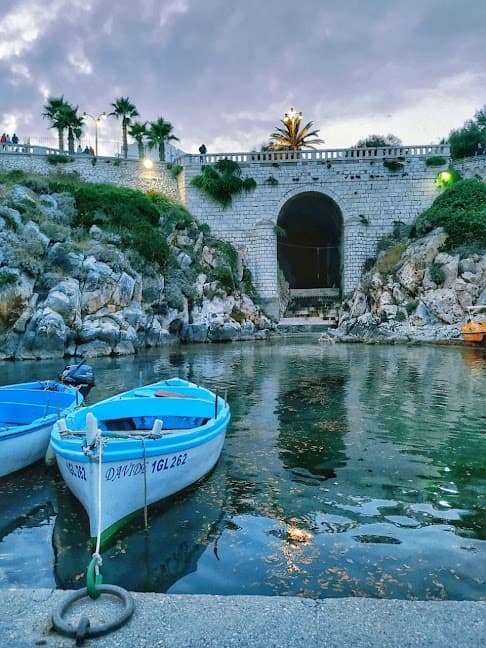


THE GORGES
South of Otranto the journey offers new emotions. The coast appears wilder, more arid and rocky, inter- rupted here and there by fascinating gorges such as Porto Badisco and continuing along the shore, the Canalone dell'Acquaviva e del Ciolo.
They were formed over the course of thousands of years, dug out by running water, then sinking to lower layers in their path to the sea. In the natural bay of Porto Badisco, narrow and deep, carpeted by the very rare Veccia di Giacomini, it seems that Aeneas might have landed, as told by Vergil in the third book of the Aeneid. Plunge into the turquoise waters, before going on to stop at the water's edge to taste the sea urchins, it will be worth your time. On clear days you can see as far as the coasts of Albania, less than seventy miles away, and if you are an expert diver, there are natural diving boards, such as the spur of rock overhanging the sea in the vicinity of the Fortino, a little bunker dating from the Second World War. Further on rise the golden cliffs of Porto Miggiano, a natural swimming pool with emerald green water. After having passed Castro, at Marina di Marittima, you will find the little bay of Acquaviva, another corner of paradise immersed in verdure. Descend a little stairway to plunge into cold water, truly refreshing!

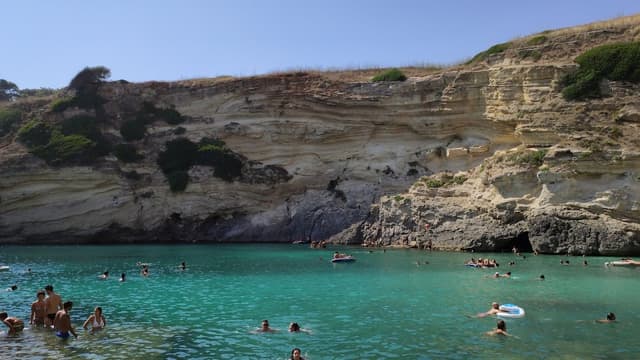
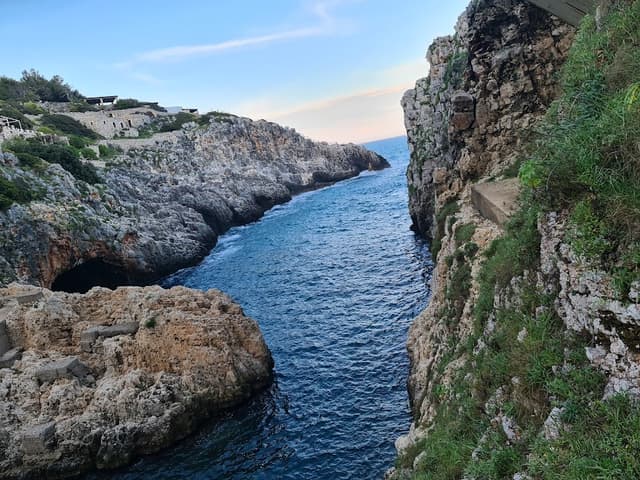

ANCIENT SENTINELS
The coast as far as Santa Maria di Leuca is high in places over 100 metres above sea level, full of fiords and gorges that open onto a sea that is unbelievably blue. Seventeen kilometres brings you from Castro to the marina of Tricase, over a gentle downhill and much steeper uphill trail, surrounded by terraced olive trees and figs, pines, oleanders and many, many coastal towers. They are all watchtowers, round or square, most of them fallen to ruins: Torre Capo Lupo, Torre del Sasso and to the south of Marina Serra, Torre Naspre and the big Torre Specchia. After the Novaglie marina, the Canalone del Ciolo, one of Salento's most beautiful fiords, four kilometres from Leuca, appears be- fore you in all its beauty, with water ranging from green to deep blue. It is the perfect place for scuba diving or if you prefer, diving from a height. The most daring can jump off the bridge that crosses the cove or climb up the "paretone" of this natural canyon and leap into the water from there. But there is another alternative; walk down to the sea on the 143 steps of the path, armed with mask and fins, to reach the many nearby grottoes.

LI ZINZULI
The Grotta Zinzulusa at Castro appears imposing from the sea if you come by boat as far as the Atrium, shaped like a big amphitheatre. If you come by foot, descend the stairs, walk 150 metres flanking the rocky ridge, traverse the Vestibule amid high walls overhanging the sea to arrive at the Corridor of Wonders, lined with stalactites and stalagmites that meet, as in the Crypt, to form imposing columns, most of them crystallised, like magic sentinels of the past. Last comes the Duomo, a dark chamber 24 metres high looming over the Cocito, a little freshwater basin from which run tun- nels and corridors, impossible to reach.

Rare biological species live here, such as the blind shrimp with no pigmenta- tion (Thiphlocaris Salentina), a sponge unique the world over, and a small colony of bats. There are numerous grottoes at Santa Maria di Leuca too, between the promontories of Punta Ristola and Punta Meliso. Rent a boat and drift out with the motor switched off to discover the ones accessible from the sea on the Adriatic Side, such as the Grotte Cazzafri with its immense ceiling filled with stalactites, or the Bocca del Pozzo, with its little blue lake and then the Grotta della Cattedrale and that of the Mannute, much visited.

The cavities are a few hundred meters apart, outside and inside the Ciolo Bay. The large one, also called Bocca del Pozzo, has an access 30 m high at sea level: inside there is a small freshwater lake. The small one is submerged (-10 m) and 120 m long: here there is a freshwater spring and an air bubble duct. In 1973 a monk seal was sighted.

6. Ugento Beach Nature Park
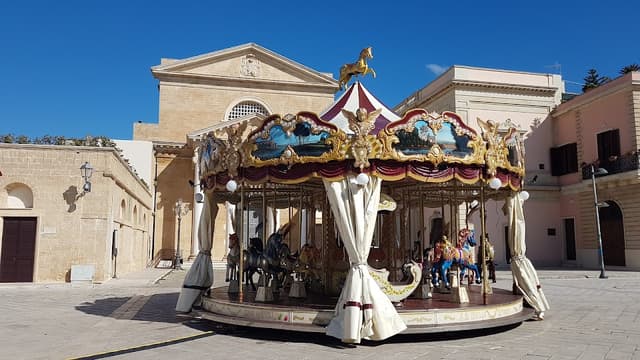
MAQUIS AND GARRIGUE
Venture into the quietest, most impervious areas, where the maquis gives way to the garrigue and the pseudo-steppe, to see the splendid wild orchids and, among the birds, sylviids, raptors and shrikes in migra- tion in spring and autumn. This area is home to hedgehogs, weasels, foxes and badgers. Among the reptiles, the most common are the rat snake, the four-lined snake and the leopard snake.
PIT STOP IN THE BASIN
The basin of Rottacapozza Sud, situated at the heart of the Park's wetlands, is surrounded by ditch reeds, rushes and a pine grove planted in the early 18th century. It is ideal for birdwatching. Water rails, little grebes and coots can be seen here all year long, along with wintering ducks in the cold months, including the truly rare white-eyed pochard. In spring and au- tumn, in addition to numerous colonies of herring gulls and cormorants, arrive elegant red and grey herons, reed warblers, little bitterns, little egrets, sguacco herons and rare flamingoes.
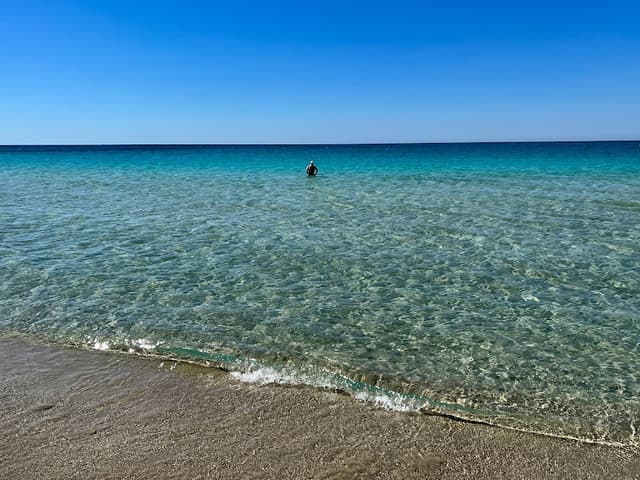
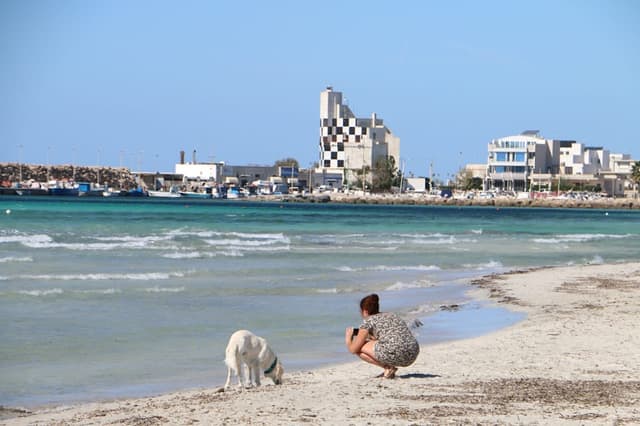
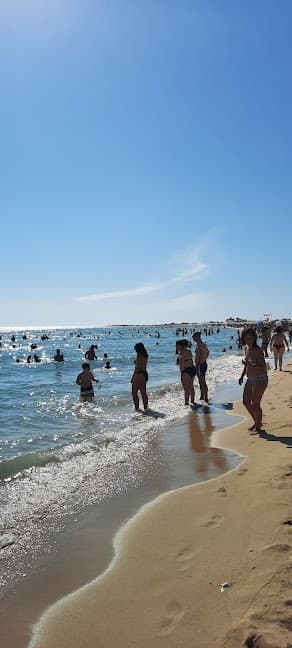
SAND DUNES AND PINE GROVES
If you chose an excursion along the sea, walk slowly over the sand, where it plunges into the sea in a perennial game of meeting and parting, with crystalline water where you can swim from April to October. Then wander through the pine grove, where the wild vegetation starts. To be sure to see everything, go with one of the environmental and touristic guides of Avanguardie, (tel. +393479527701 - +393493788738, www.avanguardie. net) who have many stories to tell about this corner of Salento. The trail is about 5 kilometres long, with no hills to be climbed.
BIKE TOUR ALONG THE CANALS
If you like biking, don't miss the excursion by bicycle that runs along the coast and through its vegetation. If you manage not to make too much noise, you will observe birds and other animals in their own environment. With a guide you can discover interesting historical and naturalist facts about the ponds and lakes in the park. The trail is 8 kilometres long, with very little elevation.
EXCURSION TO THE BASINS
SPECCHIA DEL CORNO
Another interesting excursion passes through the karst gul- lies, little canyons dug out by rainwater. They run parallel to each other and perpendicular to the coast, where fine examples of ilexes (Quecus ilex) and carob trees (Ceratonia siliqua) grow. The itinerary that leads to the "Specchia del Corno" shows how the gullies create a damp micro- climate where the vegetation flourishes amid ridges and gorges, in contrast to the rock with its spurs and terraces. The trail is 5 and a half kilometres long and has an elevation of about 65 metres.

A RUPESTRIAN DOVE-COT
Take a leap back in time in the Cupelle locality, on the road to Taurisano. Here you can see ancient limestone quarries with the signs left by mining still visible. It has been hypothesised that the big blocks mined here were used to build the nearby Messapian walls. But the surprises do not end here. Dug out of the rock is a large chamber, probably dating from medieval or modern times. Eleven metres long and 3.5 high, it was used for the intensive breeding of doves, highly appreciated from the Middle Ages to the 18th century, both for their meat and for the guano they produce, used as fertiliser in the fields.
7. Island of S.Andrea and coast of Punta Pizzo

Although bare and windswept, the Isola di S. Andrea is exceptionally precious. It is the reign of the very rare Audouin's gull, a species at risk of extinction, that nests in very few places in Italy. And here you can sight thousands of migratory and non-migratory birds, from the herring gull and the black-headed gull to such magnificent birds as the grey heron, the tufted heron, the buzzard and the marsh harrier. Its cliffs and boulders are covered with Salento sea-lavender, a true rarity, and here and there appear species with curious names, such as mullein, horned poppy and feather-grass. It has stretches of salty steppe, where nothing but the perennial glasswort, the only shrub able to survive in so much salt, grows, and to the north-west is a lagoon of brackish water abounding in reeds. There are two landing spots, for those coming from the sea: the southern one and the eastern one, where there is a building for storing boats and a hut called the "Strazza", once used as a warehouse. If you are very lucky you may see tuna far out in the sea, and approaching closer as they come and go from Cyprus. This is why the first and only tunafish hunt in Puglia was held here, up to the late 1970s.
UNDERWATER
The submerged area too is a real surprise. If you go down to a depth of 5 to 25 metres, you will find the great extension of Salento Posidonia, or Neptune grass, distinguished by robust stalks and leaves over a metre long, in which a myriad of living organisms are concealed. If you dive below the surface, you will discover Mediterranean fanworms, starfish, sea urchins and noble pen shells (Pinna nobilis), now a protected species. The colonies of Posideonia are also the habitat of the seahorse. A singular species: the males are responsible for gestation and giving birth to the babies.
PUNTA PIZZO

It would be fascinating to observe Punta Pizzo from above, by drifting over it in a hot-air balloon for instance, to discover the great variety of environ- ments that make it a real eco-museum. You would see tongues of sand, with dunes covered by an impenetrable tangle of common juniper and other plants such as sea holly, sea daffodils and marsh bellflowers that can resist the high saline content. Even the animals have had to adapt to the aridity, and the best at this are some dung-beetles and the ant lion, which digs holes in the beach and stuns its prey by throwing sand at it. A little further on, beyond the forest of Aleppo pines, you would be fascinated by two fossil dunes modelled by the wind and carpeted with white plantain, and then by the Mediterranean maquis, fragrant with myrtle and lentiscus; by the wild gardens of the garrigue, sprinkled with thyme, rosemary, Apulian heather and gorse, and then by the little meadows bright with the colours of bluebottle and many orchids, and by the pseudo-steppe. On these grasslands a few millennia ago, it is probable that men hunted the Equus hydruntinus, an extinct animal whose bones have been found in the vicinity of Punta della Suina.
NATURE TRAILS
When summer ends, Gallipoli shows another face, with hikes on foot or by bike and horseback rides to discover the Park's extraordinary biodiversity.
Trail 1-Pinewoods on the Shore. It's less than a kilometre long; here you will discover how impor- tant is the band of Aleppo pines that separates the dunes from the countryside. On one side it limits the erosion of the beach and on the other it protects the cultivated fields from salt-bearing winds. On the trees, nightingales and ox-eyes, goldfinches and chaffinches, are often seen.
Trail 2-Wetlands behind the Dunes. A slow walk 2300 metres long; interesting for its flora, and a real paradise for migratory birds. In the wetlands and amid the "Li Foggi" bogs grow marsh reeds, the habitat of the Cetti's warbler, the great reed warbler and the marsh warbler. Among the protected species you may be lucky enough to see the very rare marsh bellflower and the marsh orchid. You may come across the leopard snake or the four-lined, a big constrictor snake. Of the sea turtles0, un- fortunately severely decreased in number, only a few remain.
Trail 3-Beach Environment Nearly 4 km amid splendid sandy coves with dunes protected by common juniper, fragrant with sea daffodils, and rocky stretches formed by the fossilising of ancient dunes, covered with Statice Salentino. The sea, a few steps away, is intensely blue, inviting you to plunge in. Taking a swim is an irresistible temptation from April to October, weather permitting, so don't forget your bathing suit.
Trail 4-Punta Pizzo. An hour-and-a-quarter walk through the fresh aromas of an area rich in Mediterranean maquis and garrigue, fragrant with thyme, rosemary and lentiscus, with meadows exploding in colour and beautiful orchids such as the Ophrys apulica and the Ophrys garganica.
Trail 5-Sub-Beach Sub-Steppe Area By foot, by bike or on horseback, a trail nearly 3 km long leads through fields coloured green and blue by the Plantago albicans, or bright red by the catchfly, or yellow by the helichcrysum. A real chromotherapy en plein air!
Trail 6-Sub-Beach/ Cultivated Fields Area On the farmland, cultivated mainly to vegetables, you can observe bird species in particular, such as the lesser grey shrike and the wood- chat, the calandra lark and the magpie, and some raptors such as the buzzard. The walk, suitable for all, lasts a little over half an hour.
8. Portoselvaggio Natural Park and Palude del Capitano
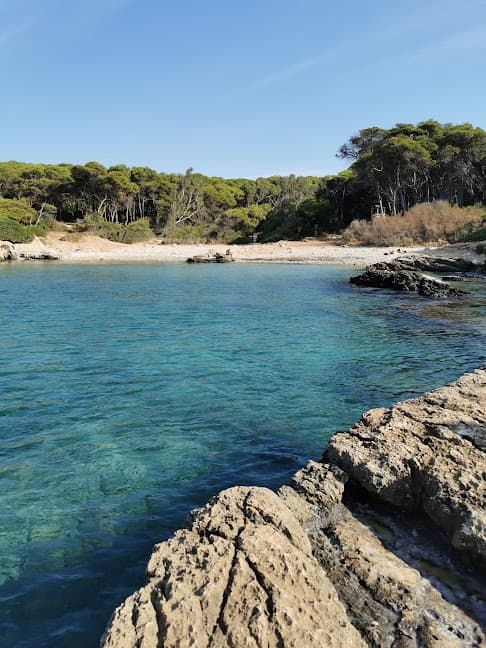
MASSERIA TORRE NOVA
On a plateau looking toward Gallipoli, between Torre Uluzzo and Torre Inserraglio, stands a beautiful 16th-century farmhouse, built over an old tower from Norman times, which has been restored as the Visitors' Center of the Park. From here you can start out to discover an exceptionally interesting ecosystem stretching from Portoselvaggio with its high, rocky coast to Torre Inserraglio, surrounded by a breathtaking landscape, as far as the Palude del Capitano.
PALUDE DEL CAPITANO
THE ULUZZO BAY
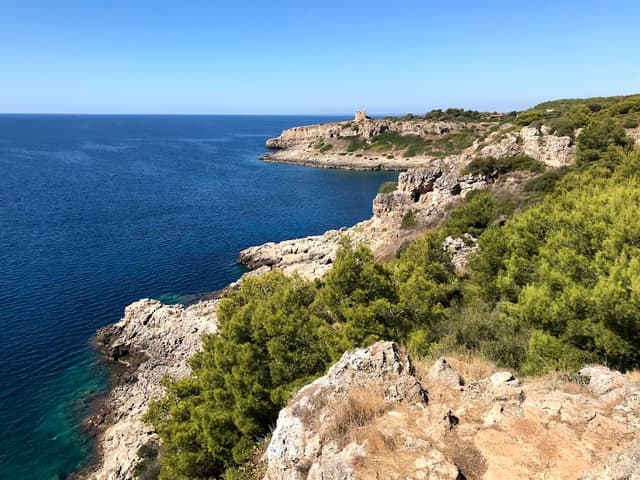
Leave your car in the parking lot and walk down to the Uluzzo Bay, which holds a special place of honour in the prehistory of the world. In the caves called "Uluzzo" and "Cavallo", a new industry was discovered for the first time. Called "Uluzziana", it was distin- guished by instruments in the form of a half-moon and necklaces of pierced seashells, dating from the beginning of the Later Stone Age. Highly impor- tant are the testimonials to artistic activity found here, most notably the numerous engraved bowls, decorated with micro-incisions consisting of bands of lines which intersect to form various figures, bearing witness to the transition from an abstract to a geometrical art. In the same cave were found several teeth of Homo sapiens dating from 45,000 years ago, allowing the presence of man in Europe to be backdated by 5000 years.
PORTO SELVAGGIO

Walk toward the bay, traversing a shady grove of pines trees, down to a tiny pebble beach opening onto a blue-green sea. In summer it is often crowded, but you need only go a few metres to the right to find space. Follow a path leading through the Mediterranean maquis, fragrant with wild thyme, juniper, myrtle and lentiscus, to arrive at little coves with tortuous gorges and old Messapian quarries, where you can take an invigorating dip in one of the numerous fresh-water springs. The path leads from one valley to another covered in grasswort, until a natural swimming pool suddenly appears among the black boulders.
UNFORGETTABLE BIKE TOURS
Pedalling along little travelled roads, you can relive the atmos- phere of ancient times. Among the many naturalist-cultural itineraries offered to discover the Park is the bike tour between the Masseria Torre Nova, Villa Tafuri and the belvedere of Torre dell'Alto, with spectacular views over the sea; the itinerary along the wine roads, to discover forti- fied farmhouses, and the "Secret Gardens" trail to admire the eclectic villas in the Cenate locality.
9. Natural Reserve Palude del Conte and Porto Cesareo Marine Area


FLYING OVER THE RESERVE
To birds in transit along the migratory routes this Reserve must appear as an incredible mosaic of land and water. Different territories, but all irresistible sources of food and shelter, with great vegetal biodiver- sity, including rare and native species. A coast that alternates beaches such as Lido degli Angeli with imposing sand dunes, and low rocky shores with innumerable caves, both above water and submerged, generated by karst phenomena, like the spunnulate of Torre Castiglione, sinkholes where the fresh spring water mingles with the sea. And then there is the little archipelago of islets and emerged reefs on the Peninsula of the Strea and the relics of the ancient Conte Marshes, Feda and Felicchie with a vast system of basins and canals. And lastly the green ex- panse of Bosco d'Arneo with its pine grove and underbrush and behind it, Mediterranean maquis and garrigue.
THE STREA AND ITS ISLETS
The herons and a great number of mud-dwelling birds have flown to Isola dei Conigli or Isola Grande, which, along with the reefs of Mojuso, Testa and Malva face the town of Porto Cesareo and, with the Strea Peninsula, are what remains of the ancient coastline after the geological upheav- als in the territory. The island of the rabbits is so called because a colony of rabbits was raised here in the free state in the 1950s. Between the two World Wars goats grazed on this is land, a natural source of food for the few families who inhabited it. Twelve hectares, 2.5 km long, it contains over 200 plant species. It has a saline environment with large stretches of grasswort, flat boulders covered with statice japigica and salt bush, and in the shallow coves, prairies of Cymodocea, which protect many fish and marine organisms. A thick pinewoods grows in the more sheltered area, while in the central part of the Strea the maquis and garrigue have spread wide, containing such botanical rarities as the Baudot buttercup and the white-flowering plaintain. The Mojuso reef too has an endemism, the mysterious and unique Salento Iris Revoluta Colasante. The Isola della Malva, lying opposite Torre Chianca, is covered with hollyhock. You could get to the Isola dei Conigli even on foot, walking through shallow water. Snorkelers in this area abounding in archaeological materials have found necks of Greek amphorae, shards of Roman pottery, ancient anchors and pieces of the highest importance such as the gold ring engraved with letters from the Phoenician alphabet discovered by chance in 1973 by amateur.

FAUNA OF TORRE CASTIGLIONE
Exerting an irresistible attraction to windhovers, harriers, grey herons, little egrets, marsh-harriers, and by night common owls and scops owls, are these sinkholes in the terrain.
The ceilings have collapsed due to karst erosion, bringing to light basins of water running into the sea, where Salt-resistant plants grow alongside such rare fish as the Mediterranean killfish, a living fossil. To get there, on the road that connects Torre Coll mena with Porto Cesareo, take as reference an ancient watchtower now reduced to a heap of ruins; it was the 15th-century Torre Castiglione. Walk ing beside the ten or so sinkholes, you can observe the old furnieddhri, trulli built of stone with an outside staircase, used by the farmers as their implements shelter or to store for working in the fields. These karst sinkholes, forming a natural barrier against fire, pastures and the sea air, have fully conserved the entire spectrum of the vegetation existing in Salento from past centuries to the present. Consequently, the area is closely studied by the University of Salento.
PALUDE DEL CONTE

The appointment is in spring to watch the spectacular passage of blackwinged stilts and gargeneys, water rails, tufted and grey herons in the wetlands to the north of Porto Cesareo, along the shore between the provinces of Taranto and Lecce. The Palude del Conte, whose name recalls a member of the noble Acquaviva family, one of the largest in Salento with its thousand hectares, now in good part drained through a system of basins and canals, is distinguished by freshwater springs, retained by the line of dunes that keeps them from flowing into the sea. Before it was drained the marsh was home to common cranes and bean geese. Imagine a sandy coast, with extraor- dinary sand dunes covered with cade, and just behind them large, wet, saline depressions covered with reeds and grasswort, and around the basins and canals, ditchweed, white sedge, fen sedge, marsh orchids and bellflowers, now increasingly rare. Hiding in the canebrake are the penduline titmouse, the great reed warbler, and the Dutch nightin- gale, whose song can be heard.
For centuries, this was an insalubrious area, little frequented except for hunting and gathering reeds and wood, for grazing and fishing. In the 17th century it was the refuge of the Taranto brigands and the Lucan drovers with their herds. The first attempts to drain it were made in the 16th century, and were then carried out systematically from 1924 to 1940.
BOSCO D'ARNEO
The original forest was a splendid expanse of ilex trees. Today, rather than forest, it could be called the Arneo Macquis. Upstream of the drainage canal we find a mixture of ilexes, Aleppo pines, red eucalyp- tus, coojong and thick underbrush with lentiscus, gorse, the rare and poisonous black bryony, a liana with heart-shaped leaves and red berries, and the stinkwood, whose name derives from the unpleasant smell of its leaves. Above the pinewoods area and the Tarantine state road, expanses of garrigue alternate with fields and pseudo-steppe. Come here in autumn and you will be surprised by the blossoming of the cyclamen and the rare Thomas's crocus.
MOUNTAINS OF SAND
This is one of Puglia's most important sand dune systems. Along the Ionian coastline, between Punta Prosciutto and Porto Cesareo, stand two very high dunes covered with such botanical rarities as centuries-old juniper and bushy thyme, which protect the long beaches of white sand. Swim at sunset, when the sun plunges into the water and the sea is tinged with red.
BLUE PATHS
The coast from Porto Cesareo to Porto Selvaggio offers over forty splendid diving places, with a subsea environment teaming with life. There is something for every desire: diving by day or by night, either easy or more difficult, through caverns, ravines and shipwrecks. Researchers from the Marine Biology Station of Porto Cesareo (University of Lecce) have established "Blue Paths" at various points in the Protected Marine Area. At Punta Giorgiella you can descend for six to twelve metres and find superimposed slabs of rock covered with green algae. In the Grotta di Torre Lapillo, a cavern with three en- trances, there are three different biocoenosis, from red algae with massive, encrusting sponges, to polychaetes to serpulidans.

The Amphitheatre (reached by boat from the little port of S. Isidoro) calls for immersion to a depth of the eighteen metres and displays an alternation of clumps of coralline and prairies of posidonia. Off the Isola dei Conigli, you can descend to twenty-five metres to discover the seabed of the Axinella, where the layer of coralline appears as an explosion of colours due to blue, purple and orange encrusting sponges, like the antler sponge, over a meter in height.
THROUGH NATURE ON FOOT
Conclusion
The home for unique & authentic travel

